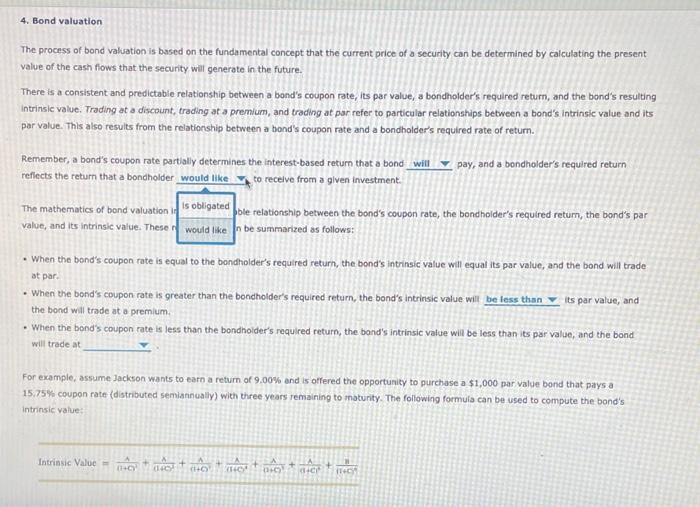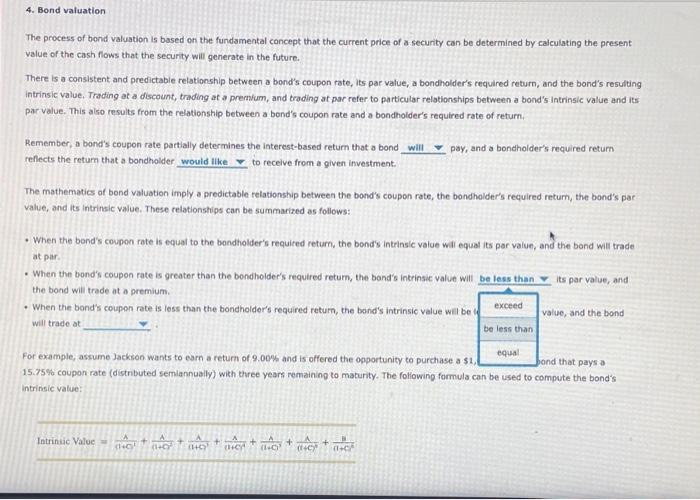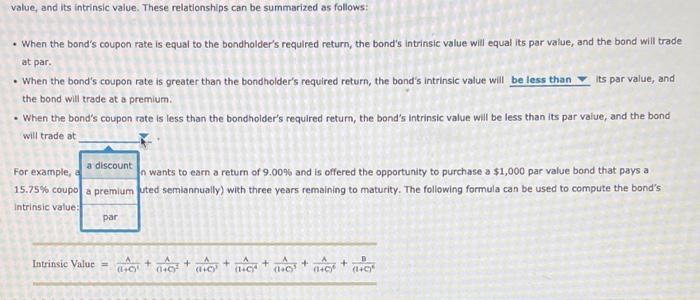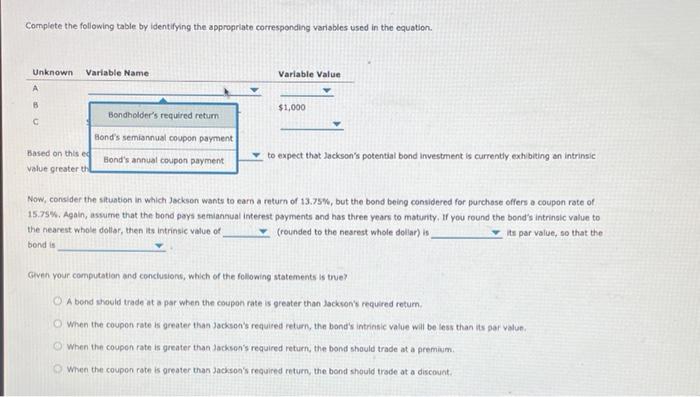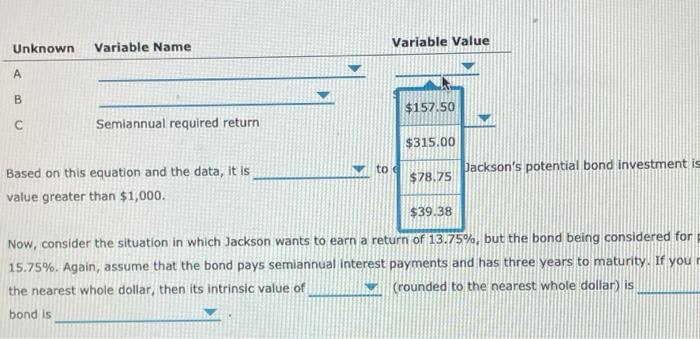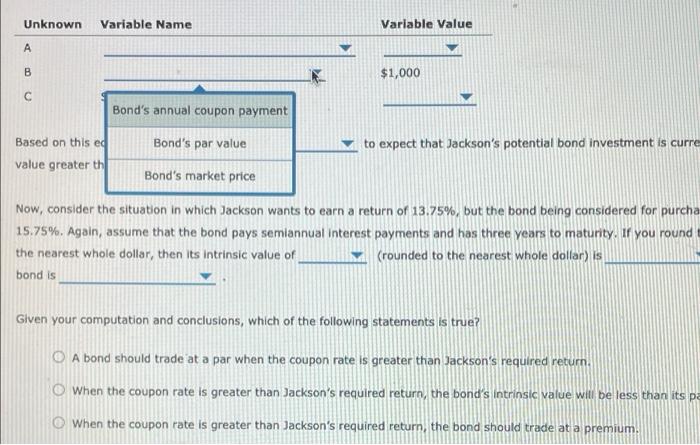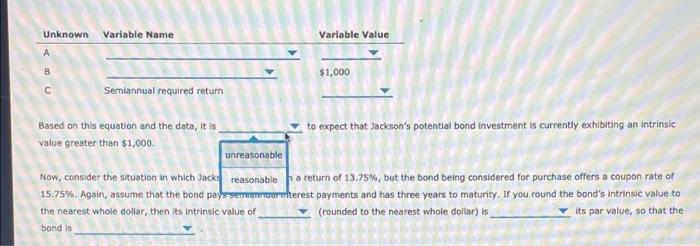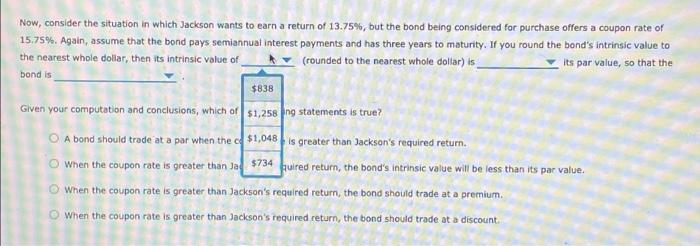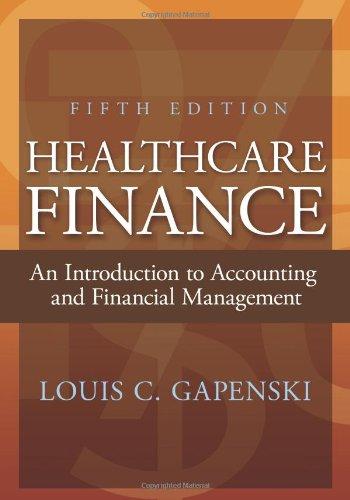4. Bond valuation The process of bond valuation is based on the fundamental concept that the current price of a security can be determined by calculating the present value of the cash flows that the security will generate in the future. There is a consistent and predictable relationship between a bond's coupon rate, its par value, a bondholder's required return, and the bond's resulting intrinsic value. Trading at a discount, trading at a premium, and trading at par refer to particular relationships between a bond's Intrinsic value and its par value. This also results from the relationship between a bond's coupon rate and a bondholder's required rate of return. Remember, a bond's coupon rate partially determines the Interest-Based return that a bond will pay, and a bondholder's required return reflects the return that a bondholder would like to receive from a given investment will The mathematics of bond valuation imply a predictable relationship between the bond's cou might the bondholder's required return, the bond's par value, and its intrinsic value. These relationships can be summarized as follows: When the bond's coupon rate is equal to the bondholder's required return, the bond's intrinsic value will equal its par value, and the band will trade at par . When the band's coupon rate is greater than the bondholder's required return, the band's intrinsic value will be less than its par value, and the bond will trade at a premium. When the bond's coupon rate is less than the bondholder's required return, the bond's intrinsic value will be less than its par value, and the bond will trade at For example, assume Jackson wants to earn a return of 9.00% and is offered the opportunity to purchase a $1,000 par value bond that pays a 15,75%, coupon rate (distributed semiannually) with three years remaining to maturity. The following formula can be used to compute the band's Intrinsic value: Intrinsic Value otot die C+++ 10 ( 4. Bond valuation The process of bond Valuation is based on the fundamental concept that the current price of a security can be determined by calculating the present value of the cash flows that the security will generate in the future. There is a consistent and predictable relationship between a band's coupon rate, its par value, a bondholder's required return, and the bond's resulting Intrinsie value. Trading at a discount, trading at a premium, and trading at par refer to particular relationships between a band's Intrinsic value and its par value. This also results from the relationship between a bond's coupon rate and a bondholder's required rate of return. Remember, a band's coupon rate partially determines the interest-based return that a bond will pay, and a bondholder's required return reflects the return that a bondholder would like to receive from a given investment. The mathematics of bond valuation is obligated ble relationship between the bond's coupon rate, the bondholder's required return, the bond's par value, and its intrinsic value. These would like in be summarized as follows: . When the bond's coupon rate is equal to the bondholder's required return, the bond's intrinsic value will equal its par value, and the bond will trade at par When the bond's coupon rate is greater than the bondholder's required return, the bond's intrinsic value will be less than its par value, and the bond will trade at a premium . When the band's coupon rate is less than the bondholder's required return, the band's intrinsic value will be less than its par value, and the bond will trade at For example, assume Jackson wants to earn a return of 9.00% and is offered the opportunity to purchase a $1,000 par value bond that pays a 15.75% coupon rate (distributed semiannually) with three years remaining to maturity. The following formula can be used to compute the bond's intrinsic value: Intrinsic Value cho lecto toto tertion 4. Bond valuation The process of bond valuation is based on the fundamental concept that the current price of a security can be determined by calculating the present value of the cash flows that the security will generate in the future. There is a consistent and predictable relationship between a bond's coupon rate, its par value, a bondholder's required return, and the band's resulting Intrinsic value. Trading at a discount, trading at a premium, and trading at par refer to particular relationships between a bond's Intrinsic value and its par value. This also results from the relationship between a bond's coupon rate and a bondholder's required rate of return. Remember, a bord's coupon rate partially determines the interest-based return that a bond will pay, and a bondholder's required return reflects the return that a bondholder would like to receive from a given investment The mathematics of bond Valuation imply a predictable relationship between the bond's coupon rate, the bondholder's required return, the band's par value, and its intrinsic value. These relationships can be summarized as follows: When the bond's coupon rate is equal to the bondholder's required return, the bond's intrinsic value will equat its par valun, and the bond will trade at par exceed will trade at When the bond's coupon rate is greater than the bondholder's required return, the band's intrinsic value will be less than its par value, and the bond will trade at a premium. When the band's coupon rate is less than the bondholder's required return, the band's intrinsic value will be value, and the bond be less than equal For example, assume Jackton wants to earn a return of 9.00% and is offered the opportunity to purchase a $1, bond that pays a 15.75% coupon rate (distributed semiannually) with three years remaining to maturity. The following formula can be used to compute the bond's Intrinsic value Intrinsic Value + + + + ch value, and its intrinsic value. These relationships can be summarized as follows: When the bond's coupon rate is equal to the bondholder's required return, the bond's intrinsic value will equal its par value, and the bond will trade at par. When the band's coupon rate is greater than the bondholder's required return, the band's intrinsic value will be less than its par value, and the bond will trade at a premium When the bond's coupon rate is less than the bondholder's required return, the bond's intrinsic value will be less than its par value, and the bond will trade at For example, a discount In wants to earn a return of 9.00% and is offered the opportunity to purchase a $1,000 par value bond that pays a 15.75% coupo a premium uted semiannually) with three years remaining to maturity. The following formula can be used to compute the bond's Intrinsic value par Intrinsic Value to + + ac + 10 + 14cm + ( 11404 (hoc 0:01 Complete the following table by identifying the appropriate corresponding variables used in the equation. Variable Name Unknown A Variable Value $1,000 B Bondholder's required return Hond's semiannual coupon payment Based on this ed Hond's annual coupon payment Value greater the to expect that Jackson's potential bond Investment is currently exhibiting an intrinsic Now, consider the situation in which Jackson wants to earn a return of 13.75%, but the bond being considered for purchase offers a coupon rate of 15.78%. Again, assume that the bond pays semiannual interest payments and has three years to maturity. If you round the band's intrinsic value to the nearest whole dotter, then its intrinsic value of (rounded to the nearest whole dolari its par value, so that the bond Give your computation and conclusions, which of the following statements is true A bond should trade ata par when the coupon rate is greater than Jackson's required retum When the coupon rate is greater than Jackson's required return, the bond's intrione value will be less than its par valun, When the coupon rate is greater than Jackson's required return, the bond should trade at a premium When the coupon rate is greater than Jackson's required return, the band should trade at a discount Unknown Variable Name Variable Value A B $157.50 Semiannual required return $315.00 Jackson's potential bond investment is $78.75 to e Based on this equation and the data, it is value greater than $1,000. $39.38 Now, consider the situation in which Jackson wants to earn a return of 13.75%, but the bond being considered for 15.75%. Again, assume that the bond pays semiannual interest payments and has three years to maturity. If your the nearest whole dollar, then its intrinsic value of (rounded to the nearest whole dollar) is bond is Unknown Variable Name Variable Value A B $1,000 Bond's annual coupon payment Based on this ed value greater the Bond's par value to expect that Jackson's potential bond investment is curre Bond's market price Now, consider the situation in which Jackson wants to earn a return of 13.75%, but the bond being considered for purcha 15.75%. Again, assume that the bond pays semiannual interest payments and has three years to maturity. If you round the nearest whole dollar, then its intrinsic value of (rounded to the nearest whole dollar) is bond is Glven your computation and conclusions, which of the following statements is true? A bond should trade at a par when the coupon rate is greater than Jackson's required return. When the coupon rate is greater than Jackson's required return, the bond's intrinsic value will be less than its pa When the coupon rate is greater than Jackson's required return, the bond should trade at a premium. Unknown Variable Name Variable Value B $1,000 Semiannual required return to Based on this equation and the data, it is value greater than $1,000. 9.2500% ckson's potential bond investment is currently e 4.5000% 6.5000% Now, consider the situation in which Jackson wants to earn a retu but the bond being considered for purchase offe 15.75%. Again, assume that the bond pays semiannual interest | 15.7500% has three years to maturity. If you round the bo the nearest whole dollar, then its intrinsic value of (rounded to the nearest whole dollar) is bond is its Unknown Variable Name Variable Value B $1,000 Semiannual required return to expect that Jackson's potential bond investment is currently exhibiting an intrinsic Based on this equation and the data, it is value greater than $1,000 unreasonable Now, consider the situation in which Jacke reasonable a return of 13.75%, but the bond being considered for purchase offers a coupon rate of 15.75%. Again, assume that the bond pays-serverwarmiterest payments and has three years to maturity. If you round the bond's intrinsic value to the nearest whole dollar, then its intrinsic value of (rounded to the nearest whole dollar) is its par value, so that the bond is Now, consider the situation in which Jackson wants to earn a return of 13.75%, but the bond being considered for purchase offers a coupon rate of 15.75%. Again, assume that the bond pays semiannual interest payments and has three years to maturity. If you round the band's intrinsic value to the nearest whole dollar, then its intrinsic value of (rounded to the nearest whole dollar) is its par value, so that the bond is $838 Given your computation and conclusions, which of $1,258 png statements is true? A bond should trade at a par when the $1,048 is greater than Jackson's required return. When the coupon rate is greater than $734 puired return, the band's intrinsic valve will be less than its par value. When the coupon rate is greater than Jackson's required return, the band should trade at a premium. When the coupon rate is greater than Jackson's required return, the bond should trade at a discount Now, consider the situation in which Jackson wants to earn a return of 13.75%, but the bond being considered for purchase offers a coupon rate of 15.75%. Again, assume that the bond pays semiannual interest payments and has three years to maturity. If you found the band's intrinsic value to the nearest whole dollar, then its intrinsic value of (rounded to the nearest whole dollar) is its par value, so that the bond is less than Given your computation and conclusions, which of the following statements is true? greater than A bond should trade at a par when the coupon rate is greater than Jackson's required return. equal to When the coupon rate is greater than Jackson's required return, the bond's intrinsic value will be less than its par valve When the coupon rate is greater than Jackson's required return, the bond should trade at a premium. When the coupon rate is greater than Jackson's required return, the bond should trade at a discount Now, consider the situation in which Jackson wants to earn a return of 13.75%, but the bond being considered for purchase offers a coupon rate of 15,75%. Again, assume that the bond pays semiannual interest payments and has three years to maturity. If you round the bond's intrinsic value to the nearest whole dollar, then its intrinsic value of (rounded to the nearest whole dollar) is its par value, so that the bond is $838 Given your computation and conclusions, which of $1,258 Ing statements is true? A bond should trade at a par when the ce $1,048 is greater than Jackson's required return. When the coupon rate is greater than Jad $734 uired return, the bond's intrinsic value will be less than its par value. When the coupon rate is greater than Jackson's required return, the bond should trade at a premium When the coupon rate is greater than Jackson's required return, the bond should trade at a discount Now, consider the situation in which Jackson wants to earn a return of 13.75%, but the bond being considered for purchase offers a coupon rate of 15.75%. Again, assume that the bond pays semiannual interest payments and has three years to maturity. If you round the band's intrinsic value to the nearest whole dollar, then its intrinsic value of (rounded to the nearest whole dollar) is its par value, so that the bond is Given y trading at a discount clusions, which of the following statements is true? trading at par ta par when the coupon rate is greater than Jackson's required return. trading at a premium greater than Jackson's required return, the bond's intrinsic value will be less than its par value When the coupon rate is greater than Jadson's required return, the bond should trade at a premium When the coupon rate is greater than Jackson's required return, the bond should trade at a discount

